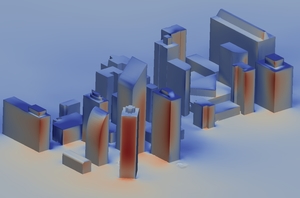Civil Engineering
Civil engineering is a discipline that deals with the design, construction, and maintenance of the physical and naturally built environment, including works like roads, bridges, canals, dams, and buildings. Civil engineering is the oldest engineering discipline after military engineering, and it was defined to distinguish non-military engineering from military engineering. It is traditionally broken into several sub-disciplines including environmental engineering, geotechnical engineering, geophysics, geodesy, control engineering, structural engineering, biomechanics, nanotechnology, transportation engineering, earth science, atmospheric sciences, forensic engineering, municipal or urban engineering, water resources engineering, materials engineering, coastal engineering, surveying, and construction engineering. Fluids in civil engineering are mostly air and water. An important questions to be answered are the forces induced by fluid motion over structures. Fluids in civil engineering are mostly air and water.
An important questions to be answered are the forces induced by fluid motion over structures. One way to gain a greater understanding of the interaction of fluids and structures is to use Computational Fluid Dynamics. CFD can help engineers, architects and designers to simulate and predict different types of flow. Some examples are listed below:
- airflow around buildings (pressure, temperature and velocity distributions),
- airflow inside buildings (air quality, age of air in rooms, air change efficiency, heating, ventilation and air-conditioning, fire hazards and smoke migration),
- wind comfort and nuisance to cyclists and pedestrians,
- pollutant concentration and removal,
- solar radiation,
- roof-mounted solar photovoltaic arrays,
- fire safety engineering,
- tunnel safety (smoke propagation in rail/road tunnel, in subway tunnel station),
- wind loads on moving bodies, especially bridges,
- reliability assessment of wave and wind energy devices,
- water loads on offshore structures,
- wave loadings on coastal houses.
Nowadays many different factors such as construction and safety standards, cost effectiveness, environmental friendliness, pollution and, subsequently, energy consumption should also be taken into account. Aesthetics also affects the design of modern architectural projects.
The use of CFD in civil engineering is extensively replacing traditional costly and lengthy methods such as wind tunnel testings in the preliminary design and evaluation phases of new projects.
-

Tall buildings
Civil engineering is a professional engineering discipline that deals with the design, construction, and maintenance of the physical and naturally built environment, including works like roads, bridges, canals, dams, and buildings.
